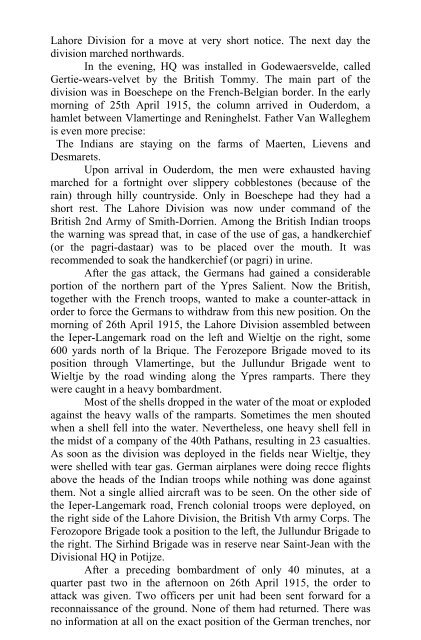HOW EUROPE IS INDEBTED TO THE SIKHS ? - Global Sikh Studies
HOW EUROPE IS INDEBTED TO THE SIKHS ? - Global Sikh Studies
HOW EUROPE IS INDEBTED TO THE SIKHS ? - Global Sikh Studies
You also want an ePaper? Increase the reach of your titles
YUMPU automatically turns print PDFs into web optimized ePapers that Google loves.
Lahore Division for a move at very short notice. The next day the<br />
division marched northwards.<br />
In the evening, HQ was installed in Godewaersvelde, called<br />
Gertie-wears-velvet by the British Tommy. The main part of the<br />
division was in Boeschepe on the French-Belgian border. In the early<br />
morning of 25th April 1915, the column arrived in Ouderdom, a<br />
hamlet between Vlamertinge and Reninghelst. Father Van Walleghem<br />
is even more precise:<br />
The Indians are staying on the farms of Maerten, Lievens and<br />
Desmarets.<br />
Upon arrival in Ouderdom, the men were exhausted having<br />
marched for a fortnight over slippery cobblestones (because of the<br />
rain) through hilly countryside. Only in Boeschepe had they had a<br />
short rest. The Lahore Division was now under command of the<br />
British 2nd Army of Smith-Dorrien. Among the British Indian troops<br />
the warning was spread that, in case of the use of gas, a handkerchief<br />
(or the pagri-dastaar) was to be placed over the mouth. It was<br />
recommended to soak the handkerchief (or pagri) in urine.<br />
After the gas attack, the Germans had gained a considerable<br />
portion of the northern part of the Ypres Salient. Now the British,<br />
together with the French troops, wanted to make a counter-attack in<br />
order to force the Germans to withdraw from this new position. On the<br />
morning of 26th April 1915, the Lahore Division assembled between<br />
the Ieper-Langemark road on the left and Wieltje on the right, some<br />
600 yards north of la Brique. The Ferozepore Brigade moved to its<br />
position through Vlamertinge, but the Jullundur Brigade went to<br />
Wieltje by the road winding along the Ypres ramparts. There they<br />
were caught in a heavy bombardment.<br />
Most of the shells dropped in the water of the moat or exploded<br />
against the heavy walls of the ramparts. Sometimes the men shouted<br />
when a shell fell into the water. Nevertheless, one heavy shell fell in<br />
the midst of a company of the 40th Pathans, resulting in 23 casualties.<br />
As soon as the division was deployed in the fields near Wieltje, they<br />
were shelled with tear gas. German airplanes were doing recce flights<br />
above the heads of the Indian troops while nothing was done against<br />
them. Not a single allied aircraft was to be seen. On the other side of<br />
the Ieper-Langemark road, French colonial troops were deployed, on<br />
the right side of the Lahore Division, the British Vth army Corps. The<br />
Ferozopore Brigade took a position to the left, the Jullundur Brigade to<br />
the right. The Sirhind Brigade was in reserve near Saint-Jean with the<br />
Divisional HQ in Potijze.<br />
After a preceding bombardment of only 40 minutes, at a<br />
quarter past two in the afternoon on 26th April 1915, the order to<br />
attack was given. Two officers per unit had been sent forward for a<br />
reconnaissance of the ground. None of them had returned. There was<br />
no information at all on the exact position of the German trenches, nor

















